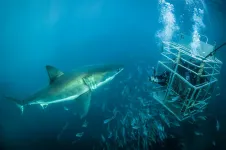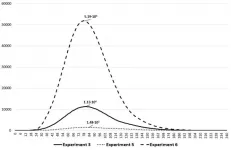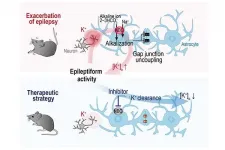(Press-News.org) Wildlife tourism including white shark cage-diving is growing in popularity, but these industries remain highly contentious amongst tourists, conservationists, and scientists alike.
Many voice concerns about possible negative impacts - especially when it targets potentially dangerous animals - while proponents cite the socio-economic benefits to justify wildlife tourism activities.
In reality, wildlife tourism is complex, requiring managers to balance the benefits and drawbacks to determine what is acceptable for such industries.
To help solve this question of "is wildlife tourism good or bad?", a tool to help managers assess these industries has been created by scientists from Flinders University, the Georgia Aquarium, and Southern Cross University with help from environmental, marine parks, and tourism managers from the South Australian Department for Environment and Water, and a veterinarian/university animal welfare officer.
The resulting framework, published in Conservation Letters, uses 26 factors to assess the industry's tractability, socioeconomic values, and effects on conservation, animal welfare, and ecosystem impacts, says research leader Dr Lauren Meyer, from the Flinders University Southern Shark Ecology Group and Georgia Aquarium.
Bringing together these five distinct categories into one framework enables a more comprehensive assessment, combining the various pros and cons typical of wildlife tourism industries.
"The latest study provides an inventory of relevant factors incorporating a range of different industry sectors, current knowledge, and research needs," says co-author and Flinders Associate Professor Charlie Huveneers.
To put the new framework to the test, the authors applied it to the white shark cage-diving industry on South Australia's Eyre Peninsula. Here, three operators host up to 10,000 passengers and generate about $8 million a year.
The industry is well regulated with limits on the number of licences, days they can operate, and amount of attractant they can use.
Recent research from Dr Meyer found that while food-based attractant (bait and berley) had no impact on white shark diet (they still swim around eating their normal prey items), it can affect the diet of fish and rays that live at these offshore islands.
The framework also enabled the comparison of the costs and benefits to white sharks versus the other fish and rays, revealing the wholistic acceptability of the industry and identifying key areas for improvement.
The results show that while public opinion varies towards white shark cage-diving, the contribution to public education and awareness, and scientific research is high, Dr Meyer says.
"The conservation outcomes for target and non-target species is high, owing to the protected status of the Neptune Islands Group Marine Park Sanctuary Zone where the industry operates," she says.
Unsurprisingly, the industry offers substantial regional economic benefits, but while the effects on white shark was well managed, the welfare of fishes and rays was identified as requiring further attention.
Associate Professor Charlie Huveneers, who has studied shark behaviour and ecology for more than 10 years, including white sharks, says the new framework shows how efficient collaboration between scientists, managers and the industry will help minimise negative effects on white sharks, but it also highlighted areas which could be further improved.
Specifically, the framework identified key priorities for future biological, socioeconomic, and cultural heritage research, ensuring comprehensive management of a divisive industry.
INFORMATION:
The article, 'A multidisciplinary framework to assess the sustainability and acceptability of wildlife tourism operations' (2021) by L Meyer, K Apps, S Bryars, T Clarke, B Hayden, G Pelton, B Simes, LM Vaughan, SK Whitmarsh and C Huveneers, has been published in Conversation Letters (Wiley) DOI: 10.1111/conl.12788 The Society for Conservation Biology (wiley.com)
Acknowledgements:
Researchers thank the cage-diving industry for ongoing assistance, support for industry management, and commitment to conversation.
A painful tradeoff between a number of infected and negative economic impact must be considered before deciding on the lockdown strategy within a city. As national economies continue to crumble, citizens wonder whether their governments did a good job at regulating the lockdown measures.
Russian city of St. Petersburg is at the frontlines of this ongoing war with Covid-19. To combat this situation effectively, Russian government allocated significant funds for the research. Results followed. Scientists from Peter the Great St.Petersburg Polytechnic University (SPbPU) modified the existing SIR class pandemic prediction model. Now it is better.
But why? What is the nature ...
Breast cancer is the commonest fatal cancer in women. Early detection increases a woman's chances of recovery. Magnetic Resonance Imaging (MRI) is an accurate technique for detecting and classifying tumours in breast tissue. However, it sometimes causes "false alarms", thus requiring further investigation (biopsy) and in some cases even resulting in so-called overtreatment, that is to say unnecessary surgery. For the first time, a research team from MedUni Vienna has now confirmed a threshold value for a non-invasive imaging biomarker. This can be incorporated into short standard MRI scans ...
Without electronics and photonics, there would be no computers, smartphones, sensors, or information and communication technologies. In the coming years, the new field of phononics may further expand these options. That field is concerned with understanding and controlling lattice vibrations (phonons) in solids. In order to realize phononic devices, however, lattice vibrations have to be controlled as precisely as commonly realized in the case of electrons or photons.
Phononic cyrstals
The key building block for such a device is a phononic ...
Tohoku University scientists and their colleagues in Germany have revealed that a first-time exposure to only a brief period of brain hyperactivity resulted in an acute breakdown of the inter-cellular network of glial cells. Pharmacological intervention of the glial plasticity may provide a new preventative strategy for fighting epilepsy.
The findings were detailed in the Journal of Neuroscience.
Epilepsy is a disorder characterized by neuronal hyper-excitation and a progression of seizures with each episode. Anti-epileptic drugs are mostly aimed at suppressing hyperactivity, ...
Results of a 2018 multirocket launch at Poker Flat Research Range north of Fairbanks, Alaska, will help scientists better understand the impact of more water vapor accumulating near the fringe of the Earth's atmosphere.
"This is the first time anyone has experimentally demonstrated that cloud formation in the mesosphere is directly linked to cooling by water vapor itself," said Irfan Azeem, space physicist at Astra LLC in Louisville, Colorado, and principal investigator of the Super Soaker mission.
The NASA-funded project, named Super Soaker, ...
In recent years, European forests have suffered greatly from extreme climate conditions and their impacts. More than half of Europe's forests are potentially at risk from windthrow, forest fire, insect attacks or a combination of these. This is the main result of a study by an international team of scientists with the participation of Henrik Hartmann from the Max Planck Institute for Biogeochemistry in Jena, Germany. Using satellite data and artificial intelligence, the scientists studied vulnerability to disturbances in the period between 1979 and 2018. In the light of ongoing climate change, their findings are very important for improving mitigation and adaptation strategies ...
Materials called perovskites can be more readily incorporated into silicon-based semiconducting platforms by using a microfluidic pumping technology developed at KAUST.
The perovskites currently being explored for many applications in new technologies are diverse materials sharing the same crystalline structure as the natural mineral perovskite. These semiconducting materials show great promise in a variety of optoelectronic applications, such as light emitters, sensors and solar cells.
Compared to traditional semiconductors, perovskites are soft and unstable. "This makes it difficult to pattern them using standard lithography methods," says materials scientist Iman Roqan at KAUST.
The challenge tackled by Roqan and her colleagues was to adapt microfluidic technologies to manipulate ...
COLUMBUS, Ohio - Parents may fear that if their high school student isn't motivated to do well in classes, there's nothing that will change that.
But a new study that followed more than 1,600 students over two years found that students' academic motivation often did change - and usually for the better.
Results showed that increasing students' sense of "belongingness" in school was one key way of increasing academic motivation.
"Our results point to a more hopeful picture for students who start out with lower levels of motivation - they tend to shift toward more adaptive ...
March 1, 2021 - A new paper published online in the Annals of the American Thoracic Society discusses how smoking may affect risk for COVID-19 and the types of research that are needed to better understand the link between smoking and COVID-19 risk.
In "Smoking and COVID-19: The Real Deal," Enid Neptune, MD, and Michelle N. Eakin, PhD, of the Division of Pulmonary and Critical Care Medicine, Johns Hopkins University, discuss research to date on this topic and propose areas of research that can help clarify this relationship.
Studies have shown that current smokers with COVID-19 have twice the ...
New research has determined the prevalence of private security systems may be robbing the general public of the police services they need.
Dr. Ross Hickey is an economist in UBC Okanagan's Faculty of Management and the Irving K. Barber Faculty of Arts and Social Sciences. Along with a team of researchers, Hickey examined data from a social survey of Canada victimization, where people answered whether they had added security measures to their homes to protect themselves from crime.
"We are seeing more expenditures on private security systems installed in homes and, as economists, we have to ask why. We know that crime rates are down and expenditure on police is up," says Hickey. "But private security purchases are at an all-time ...





